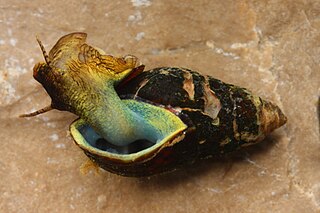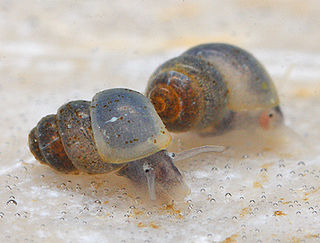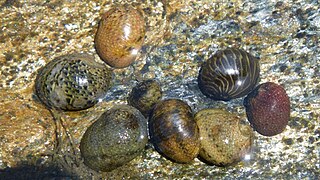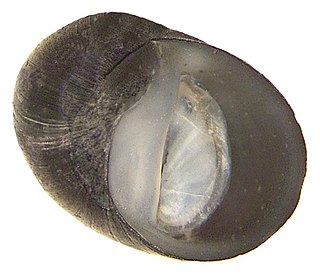
Neritidae, common name the nerites, is a taxonomic family of small to medium-sized saltwater and freshwater snails which have a gill and a distinctive operculum.

Theodoxus danubialis is a species of small freshwater snail with an operculum, an aquatic gastropod mollusk in the family Neritidae, the nerites. The species is considered as endangered in Germany, Austria and in the Czech Republic.

Theodoxus fluviatilis, common name the river nerite, is a species of small freshwater and brackish water snail with a gill and an operculum, an aquatic gastropod mollusk in the family Neritidae, the nerites.

Bithynia leachii is species of small freshwater snail with an operculum, an aquatic prosobranch gastropod mollusk in the family Bithyniidae.

Esperiana esperi is a species of freshwater snail with an operculum, an aquatic gastropod mollusk in the family Melanopsidae.

Vittina natalensis, common name spotted nerite, is a species of small freshwater snail with an operculum, an aquatic gastropod mollusk in the family Neritidae, the nerites.

Theodoxus is a genus of nerites, small water snails with an operculum, some of which live in freshwater, and some in both freshwater and brackish water, aquatic gastropod mollusks in the family Neritidae, the nerites.
Theodoxus numidicus is a species of small freshwater snail with an operculum, an aquatic gastropod mollusk in the family Neritidae, the nerites.

Esperiana daudebartii is a species of a freshwater snail with an operculum, an aquatic gastropod mollusk in the family Melanopsidae.

Bythinella austriaca is a species of very small freshwater snail with an operculum, an aquatic gastropod mollusk in the family Amnicolidae.
Neritona granosa is a species of freshwater snail with an operculum, an aquatic gastropod mollusk in the family Neritidae, the nerites.

Clithon faba is a species of brackish water snail with an operculum, a nerite. It is an aquatic gastropod mollusc in the family Neritidae, the nerites.

Theodoxus prevostianus is a species of small freshwater snail with an operculum, an aquatic gastropod mollusk in the family Neritidae, the nerites.

Theodoxus jordani is a species of freshwater snail with an operculum, an aquatic gastropod mollusk in the family Neritidae, the nerites.

Theodoxus anatolicus is a species of a freshwater snail with an operculum, an aquatic gastropod mollusk in the family Neritidae, the nerites.

Clithon corona is a species of brackish water and freshwater snail with an operculum, a nerite. It is native to the Western Pacific, from the Philippines to Micronesia, Papua New Guinea, the Solomon Islands, Vanuatu, New Caledonia, Samoa, Taiwan, and the Okinawa and Ryukyu Islands of Japan.
Theodoxus valentinus is a species of freshwater gastropod in the nerite family, native to natural freshwater channels in Valencia, Spain. This species was believed extinct, but has recently been rediscovered to persist in small populations in three different sites.













